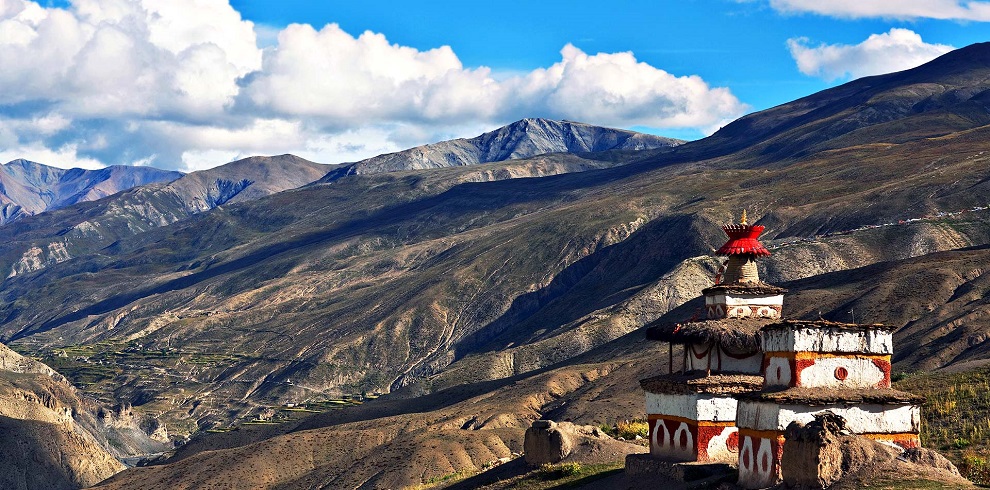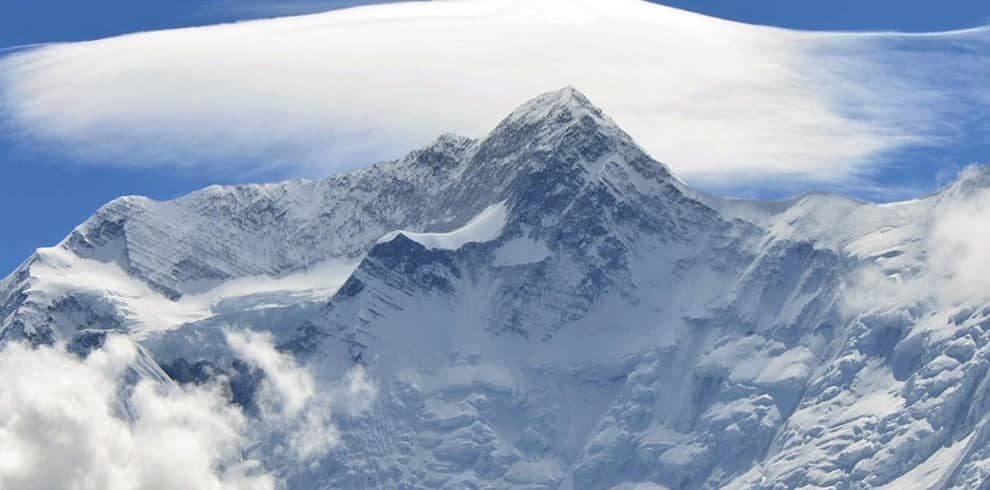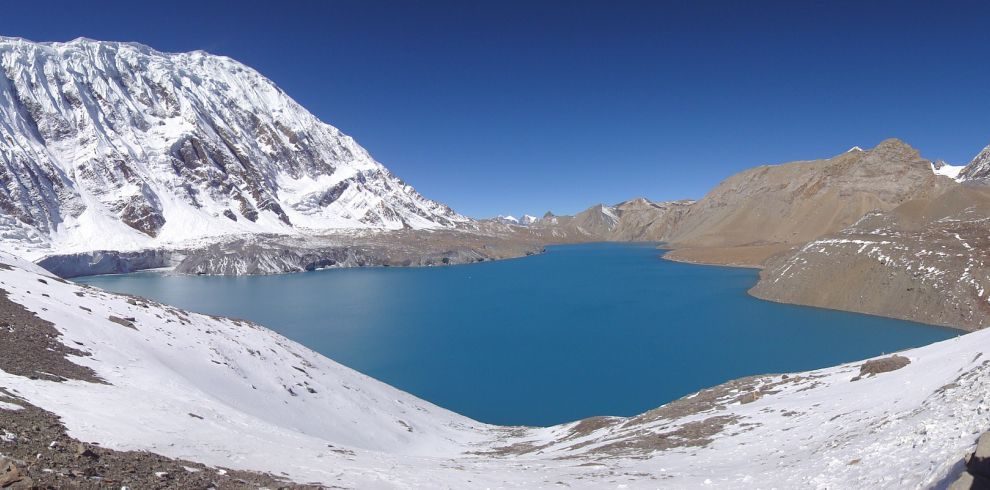Introduction To Dolpo Trekking In Nepal
The Dolpo Trek brings us to a remote part of Nepal near the Tibetan border. It’s a rural and well-preserved environment that has remained unchanged for ages.
You will be able to observe the residents’ way of life, which has remained mostly unchanged throughout the years. It is one of Nepal’s most beautiful, but also least developed, locations due to the high passes trail, which sees few visitors.
Foreigners were not allowed access to it until a few decades ago, and now it is a restricted location that requires special authorization.
The Shey Phoksundo National Park, Nepal’s largest national park, is located in the Dolpo region and is home to rare flora and animals, including the blue sheep and snow leopard.
It’s the backdrop for the Oscar-nominated film “The Caravana” or “The Himalaya,” which Peter Matheson details in his best-selling book “The Snow Leopard.”
We pass through magnificent valleys, little towns, and mountains, including the holy “Crystal Mountain,” centuries-old monasteries, and pine and oak forests on this trek.
We fly to Juphal through Nepalganj after experiencing the historical wonders of Kathmandu and acquiring the unique permit required for our upper Doplo hiking.
Then we hike north to Shey Phoksundo National Park before joining the historic Nepal Tibet trade route and ascending to Nangdola pass (5110m), stopping to take in the views of the Dolpo valley before heading to the pristine Phoksundo Lake, which is surrounded by weathered red and brown hills.
Then it’s on to Ringmo village, Shey Gompa, and then back to Jupal along the trans-Himalayan trade route.
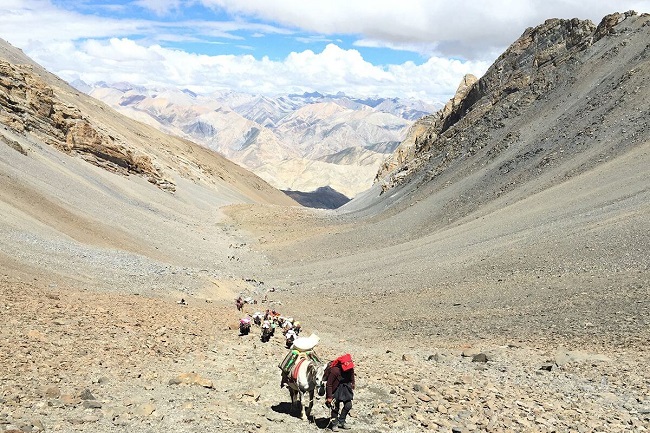
Highlights Of Dolpo Trekking In Nepal
- Nepal’s rare route
- In Shey Phoksundo National Park, you might glimpse a tiger, and you can gaze out over the turquoise waters of Lake Phoksundo.
- Explore historic monasteries.
- Shey Phoksundo is one of the large national parks.
Benefits Of Dolpo Trekking
- Private transportation to and from our Kathmandu hotel to Tribhuvan International Airport, Kathmanduâ€TMs international airport (TIA).
- To check blood oxygen saturation levels at high altitudes, bring a pulse oximeter. It’s a crucial signal for spotting early indicators of imminent altitude sickness and other health hazards.
- Medical Supply Kit
- If you don’t have your own, make arrangements for sleeping bags and down jackets.
Equipment Checklist
Equipment lists for The Upper Dolpo Trek
It is recommended that you bring the necessary clothing and equipment for the hike. Although we appreciate that our clients have their own wardrobe preferences, the following are ideas that should be brought. The main luggage, which should not weigh more than 20kg, will be carried by porters. Equipment can also be rented in Kathmandu.
Head
- Scarf or hat for the sun
- Winter hat, insulating hat, or a hat with a wide brim
- Extra batteries for the headlight
Face
- Sunscreen
- Sunglasses that block UV rays
- Wipes for the face and body
Hands
Lightweight gloves
Heavyweight winter gloves
Body
- Shirts for hiking
- Shirt with a long sleeve made of synthetic fiber.
- Rain jacket with hood
- Jacket made of fleece
- Cotton pants that are light and airy.
- T-shirt (bring lightweight wool)
- Underwear made of polypropylene
- Jacket with down feathers (available for rent in Kathmandu)
- Sweater
- Jacket and pants that are waterproof
Footwear
- Boots for Hiking
- Socks made of thick wool (Take an extra pair of thick light socks)
Essential gear
- A daypack or a backpack (Size depends on whether you take a porter or not)
- Bottle with a heating element
- Purification of water
- Pole for hiking
- Bag for sleeping (-15 degree bag is best for high altitude trekking)
Toiletries
- a drying towel of medium size
- Toothbrush
- Toothpaste
- Deodorant/floss/toilet paper
- Biodegradable soap in a bar
- a pair of nail clippers
- Mirror, little
Personal accessories
Money
Watch
Cell phone
Camera
Extra items
- Kit for first aid
- Extra passport pictures and passport photocopies
- Pencil and notebook
- Binoculars
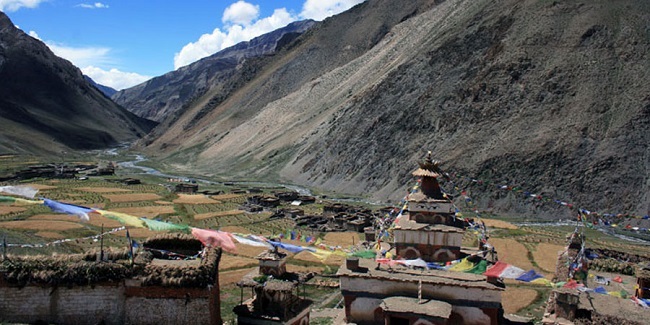
Trip Information
Getting there
Because Tribhuwan International Airport in Nepal’s only international airport, you will arrive in Kathmandu. Arrival in Kathmandu necessitates an overnight stay in a hotel. The next day, we’ll take the bus or a local vehicle to our location.
Free airport pickup
On your arrival, we will pick you up from the airport and drop you off at your hotel in a private vehicle, and vice versa on your departure. Our agent will be holding a booklet with your name on it at the Tribhuvan International Airport. As a welcoming gesture, they will either give you a Khada or Marigold garland and then drive you to your accommodation. To take use of this free service, please provide your flight information.
Accommodation
The Upper Dolpo Hike is primarily a camping trek lasting 18 days. You will be given a high-quality tent, such as Mountain Hardwear or equivalent, to share with one other member. For added comfort and warmth, each tent will contain a thick down-filled mattress.
At the base camps, we’ll have dinner, a kitchen tent with a table and chairs, a tent for personnel, and a toilet tent with a commode. You will need three nights in Kathmandu to rest before and after the hike, which is not included in the program. There is a wide choice of hotels to suit all budgets.
The room is virtually twin-sharing-style, with a bed, mattresses, blankets, and pillows. Showers will be available for an additional fee. In the Himalayan region, we have good public relations with local service providers.
Meals
This trek’s lunch package is really convenient. The meals will be chosen from the lodge’s menu and will be fresh, hygienic, flavorful, and nutritional. Traditional local, Asian, and western cuisines are represented on the menu. At high altitude, we strongly recommend liquids such as green tea, lemon tea, hot lemon, ginger tea, and garlic soup (must), among others. Meals in Kathmandu are not included in the packages, although there is a wide selection of Nepalese and international cuisine to pick from, depending on our preferences.
Best Season
When selecting whether or not to trek to the Upper Dolpo Trek, one of the most crucial factors to consider is the weather. Trekking is best done during the spring, summer, and autumn. Strong winds, storms, and slick terrain make trekking difficult during the winter and monsoon seasons.
January – February
This is the coldest period of year, especially in early January and early February. The weather can be bitterly chilly. Even if the weather is pleasant during the day with bright skies, the night will be quite chilly. Trekking is not recommended during this time.
March – April
The Upper Dolpo Trek is best done during this time of year. Throughout the hike, the weather is really pleasant. There will be breathtaking vistas of the central Himalayan range. Temperatures may begin to rise in mid-March, and bright sky will allow snow mountains to be viewed at their best. During this period, many hikers often complete their journey. The rhododendron blossoms will be blossoming at their peak along the way, with a wide range of hues.
May – June
This is also a great time to go hiking shortly before it rains. Nepal’s rainy season runs from the end of June until the middle of August. The walk is much more fun in the spring and summer.
July – August
This is when the rainiest part of the year occurs. Because the region is under the rain shadow, trekking during the monsoon months is a good alternative.
September – October
This is also one of the best times to walk in the Upper Dolpo. Due to the pleasant weather, this is the busiest season for travelers. As the monsoon begins to fade, a great trekking climate emerges. The temperature reaches a high of 20 degrees during the day and drops to 5 degrees at night.
With a beautiful sky and a spectacular view of the mountains, this is the best time for trekkers to go. It is strongly suggested because it is the optimum time to go on the Upper Dolpo trek, which is normally from mid-September until the end of October. Tourists are also drawn to Nepal during this season by the country’s two major festivals, Dashain and Tihar.
November – December
As the winter season progresses, snow begins to fall, making travel difficult. The nights will become cooler. Keep in mind that seasonal migration occurs during this time, and many residents from Lo Manthang and the neighboring areas will go to lower elevations for the winter.
November is the busiest month since it is the clearest month with the most beautiful days. The daytime temperatures are fairly steady and consistent, allowing for a spectacular view of the bright blue sky and mountain. The temperature begins to drop in December, and snow begins to fall.
Acclimatization
Many trekkers experience altitude sickness, which requires rapid care and should not be disregarded. Our trekking leader and guide have thorough first aid training and vast Himalayan expertise. We strongly advise you to notify your group leader and guide as soon as you notice any symptoms; we guarantee your health will be in good hands. Precautions will be suggested by your hike leader or guide.
The ideal strategy is to take it slowly and drink at least 4 liters of water every day. If altitude sickness is severe, the only treatment is to descend promptly. Please keep in mind that your group leader has the final say on whether or not to continue climbing based on your general health. It’s critical to remember that some people are more vulnerable than others.
Trip Grade: Fitness level, Medical, and Health
The Upper Dolpo trip is a wonderful yet slightly difficult trek. The hiking will take between 5 and 7 hours per day, depending on the location, with several stops to savor the magnificent views. Long climbs, sharp descents, and a steep forward trail on rocky trails and woodlands are all part of the trek routes. The more fit you are, the more pleasant and pleasurable your hike will be. This may be an advantage for you if you have trekking experience or enjoy it. This walk is not recommended for individuals with delicate medical problems like heart disease or lung disease.
Trekking group/single
We organize both group and private treks. Group discounts are available dependent on the size of your group. The larger your group, the greater the savings. Please see our price list for further information. Simply click the – we offer group discounts – link on the right.
We can accommodate any size group. Each group will have a guide, and we will assign a porter to every two trekkers. We will provide an assistant guide for groups of 12 or more.
A typical day on the trek
Climbing, admiring the scenery, snapping photos, touring the local communities, and tasting traditional delicacies are all part of each day’s walk.
Our skilled guides/Sherpas will accompany you during the walk. They can also give you information about the sites you’ll be visiting. Porters will transport your bags, however, you may need to keep your valuables in an ordinary backpack.
The day begins with a nice cup of tea or coffee in the morning. Following a hearty breakfast, we start out on our daily walk at about 7 to 8 a.m., depending on the length and character of the hike that day.
We will feed you lunch about midday, often on the way to the next site, after a three to four-hour hike. We take a break for about an hour before returning to the trails.
The afternoon stroll is usually shorter, lasting between two and three hours. You can snack on the extra dietary food once you get to your overnight lodge/tea house/tent. Then you’re free to go exploring in the area.
Dinner is served between 6 and 7 p.m. Your trip leader will brief you on the next day’s plans after dinner and before you go tonight. You can engage in social interactions, read books, or play games like monopoly, chess, or cards after this briefing. Mountaineering documentaries are also available if they are available. Most foreigners enjoy studying Nepali with our crew because it is a light and enjoyable language.
Communication on trek
There is a nominal service charge to use the internet at the lodges. You will, however, communicate via phone at high altitudes for safety reasons.
At least once a day, our office communicates with all trek groups via trek leaders to learn about trek conditions. In Kathmandu, you can get a local sim card, although the signals may not be powerful enough depending on the network.
In teahouses/lodges, there is free Wi-Fi, but you must pay a service fee to utilize it.
Extra personal expenses on trekking
Although this package covers a substantial portion of the route, it does not cover all expenses. All of our valued clients will require spending money to cover expenses such as lunch and dinner in Kathmandu, visa application fees, travel insurance policy purchases, snacks, Wi-Fi, alcohol, hot (tea/coffee) and cold drinks, tips for trekking crew members, souvenirs, and other miscellaneous expenses. We recommend bringing cash (in the form of dollars) to exchange for rupees. Only Nepali money is accepted in trek areas.
Electricity and water during the trek
Electricity for camera and mobile phone recharge is available throughout the lodges on the way to Everest Base Camp. During the trip, you can purchase packed mineral water at local lodges and en-route shops, or fill your water bottle with boiled water for an additional fee at lodges/teahouses. If necessary, we can also give you a water-purifying pill.
We strongly urge you not to drink water from rivers, taps, or wells in trek locations because the water may not be safe to drink.
Insurance Policy
This Dolpo Trek expedition requires travel insurance. Before beginning the hike, all trekkers must produce a copy of their comprehensive travel insurance policy certificate to us. Medical and emergency repatriation must be covered, as well as helicopter rescue and evacuation costs at high altitudes (up to 6000m).
Based on the experiences of our former clients, we may recommend insurance firms to you. We do not, however, sell insurance coverage. Within a week of booking the trek, we ask that all trek participants provide us with their comprehensive insurance information. In an emergency, we’ll prepare a speedy, successful rescue using your insurance policy and other documentation you supplied us.
Before you acquire travel insurance, call your provider and double-check that it covers helicopter rescue and evacuation up to 6000 meters. Do not rely solely on the material of the insurance company’s website.
Passport and visa
Except for Indian nationals, all foreigners must have a valid visa to enter Nepal. At Tribhuvan International Airport and Nepal’s borders with India and Tibet, you can obtain an on-arrival visa. Visit www.immigration.gov.np. for additional details.
You’ll need a passport that’s valid for at least six months, a passport-size photo, and visa fees to apply for a visa. A 30-day visa costs $50 at the moment (to be paid in cash).
A free visa will be given to children under the age of ten. It is strongly recommended that you examine the current regulations. Visa regulations are subject to change at any time. Citizens of China and members of the South Asian Association for Regional Cooperation (SAARC) (Bangladesh, Bhutan, India, Maldives, Pakistan, and Sri Lanka) are exempt from visa fees.
Certain countries’ citizens may be denied a visa upon arrival. On-arrival visas are not available for citizens of Nigeria, Ghana, Zimbabwe, Swaziland, Cameroon, Somalia, Liberia, Ethiopia, Iraq, Palestine, and Afghanistan. If you are a citizen of one of these countries, please contact the Nepalese Embassy in your country.
Before we embark on our journey, we’ll double-check everything (luggage, equipment, etc.) during our briefing.
Money exchange
Nepali Rupees (NPR/Rs) are the local currency.
(1 USD = ~ Rs.124 NPR).
You can exchange major foreign currencies through local banks and legitimate money exchanges in Kathmandu and all over Thamel. Legitimate money exchanges display their ongoing exchange rates visibly to the public.
Please note – only 100 INR (Indian Rupees) and 2000 INR notes are legal in Nepal.
Despite having the security advantage of traveler’s cheques, we prefer cash exchange. It helps avoid lengthy processes and high bank commissions.
You can withdraw cash (in Rupees)from ATMs all over Kathmandu and Thamel itself. Many of these ATMs are open around the clock. The maximum withdrawal amount is 35,000 Rupees for a 500 Rupees processing fee for foreign cards.
If you use the money exchange facilities at banks and financial institutions, they impose a service charge fee of about 4% or more.
During the trek, there are no banks and money exchange services so you should exchange your money in Kathmandu, depending on how much personal expense you require. Only Nepali Rupee is accepted in trekking regions.
Most established banks in Asia will only accept foreign currency notes that are not old, torn, or faded. Please ensure that you have new, clean notes.
Luggage
Our porters will carry your main luggage, which should not weigh more than 20 kilograms. Trekkers will bring a light backpack with them so they can easily reach water, a camera, toilet paper, and warm layers of clothing. Any surplus luggage can be stored at our office and picked up after the trek.
Safety
We ensure the safety, security, and contentment of our clients. For us, the most crucial concern is safety. We will be carrying all of the essential gear, equipment, and first-aid kits for the hike. Our leaders and guides are well-versed on the subject and have received comprehensive first-aid training. If a trekker becomes ill as a result of the altitude, it is up to the leader to decide whether or not to continue, as health is paramount. During the journey, each group will stay together to ensure that no one gets separated.
Responsible travel
We are firm believers in environmental stewardship and make every effort to leave just our footprints in the trek areas. No trekkers will visit these locations tomorrow if we do not preserve them today. As a result, we only organize eco-tours. We collaborate with the Kathmandu Environmental Education Project (KEEP) to plan environmentally sustainable itineraries that fulfill the needs of both tourists and locals.
Our Crew
Our knowledgeable guide/Sherpa will accompany us on the trek to ensure your safety and comfort. Your stuff will be carried by porters.
Our members are locals from high Himalayan remote places, and they have exceptional physical endurance at high altitudes.
We value all of our employees, so we pay them well and take care of their insurance, clothing, food, and lodging throughout the trip. When our guides and porters become unwell or injured, they receive medical attention.
Only happy people can make others happy, thus we always make sure that our team members are happy. Members of our trek/expedition team have the following qualifications:
- Authorized Trekking Guide Training Certificate
- Intensive Wilderness First Aid Training
- Fluency in English and another major language
- Conservation and Biodiversity Training
- Experience with rock climbing
Tipping
Tipping is accepted in Nepali culture. Tipping is a wonderful way to express gratitude for the service you’ve received. Tipping, on the other hand, is up to the trekker’s discretion and should be commensurate with the level of service received. We invite you to go on a vacation together and at the finish.
Booking and payment process
We are a government-approved and bonded trek and tour company in Nepal. We are also members of the Nepal Mountaineering Association (NMA) and the Trekking Agency Association of Nepal (TAAN) (NMA). As a result, you may book your trek/expedition with complete trust.
As a deposit, we require 10% of the total trip cost. Within a week of booking, please send your documentation, including a copy of your passport, passport-size pictures, travel insurance policy, and arrival and departure flight information.
You can make a 10% deposit via bank transfer, western union, or online payment on our website, and the full balance when you arrive in Nepal. Cash, bank transfer, and credit cards are all acceptable methods of payment. In addition, you will receive payment choices in your email.
Last-minute booking
Even though it is always a good idea to plan ahead for your excursions. However, for those who are unable to do so, we provide a special last-minute booking option. To take advantage of this benefit, you must pay the entire trip cost 24 hours before the trek’s departure.
Even while we do our best to plan treks at any time, there is a small potential of a trek delay due to events beyond our control, such as the inability to obtain air tickets or unfavorable weather.
Trip extension
If you wish to stay in Nepal for a few days after the trip, we can arrange enjoyable activities for you, such as exploring areas in and around Kathmandu, Chitwan jungle safari, paragliding, rafting, canoeing, and so on.
Feedback
We offer a farewell meal at the end of the trek, and we will also award you with a trek completion certificate after dinner (hard copy). It’s also a great opportunity to tell us about your experience and provide us feedback.
You may also visit Annapurna Circuit Short Trek-Cost, Distance, Itinerary, In Nepal – 10 Days
Overview Of Dolpo Trek
- The Dolpo Trek is a wild and rough trek that encourages you to discover Nepal’s stunning western area.
- The Shey-Phoksundo National Park will be the focus of our journey. This breathtaking location is regarded as one of the world’s most gorgeous parks, and you’ll see why when you see the intense turquoise Phoksundo Lake and Nepal’s highest waterfall!
- While exploring this magnificent place, we will also appreciate the fauna and amazing vegetation.
